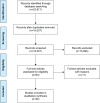Prevalence and severity of pain in adult end-stage renal disease patients on chronic intermittent hemodialysis: a systematic review
- PMID: 27382261
- PMCID: PMC4922783
- DOI: 10.2147/PPA.S103927
Prevalence and severity of pain in adult end-stage renal disease patients on chronic intermittent hemodialysis: a systematic review
Abstract
Objectives: Understanding the epidemiology of pain in patients on hemodialysis (HD) is crucial for further improvement in managing pain. The aim of this study was to systematically review available evidence on the prevalence and severity of pain in adult end-stage renal disease patients on chronic intermittent HD.
Materials and methods: We carried out a systematic review of the literature and developed a comprehensive search strategy based on search terms on pain and HD. We searched the databases MEDLINE, Scopus, PsycINFO, and CINAHL from the earliest date of each database to July 24, 2014. Manuscripts in all languages were taken into consideration. Two authors performed each step independently, and all disagreements were resolved after discussion with the third author. The quality of studies was estimated using the STROBE checklist and Cochrane risk-of-bias tool.
Results: We included 52 studies with 6,917 participants. The prevalence of acute and chronic pain in HD patients was up to 82% and 92%, respectively. A considerable number of patients suffered from severe pain. Various locations and causes of pain were described, with most of the studies reporting pain in general, pain related to arteriovenous access, headache, and musculoskeletal pain.
Conclusion: The findings of this systematic review indicate high prevalence of pain in HD patients and considerable gaps and limitations in the available evidence. Pain in this population should be recognized as a considerable health concern, and the nephrology community should promote pain management in HD patients as a clinical and research priority to improve patients' quality of life and pain-related disability.
Keywords: epidemiology; hemodialysis; intensity; pain; prevalence.
References
-
- Kovesdy CP, Mehrotra R, Kalantar–Zadeh K. Battleground: chronic kidney disorders mineral and bone disease – calcium obsession, vitamin D, and binder confusion. Clin J Am Soc Nephrol. 2008;3(1):168–173. - PubMed
-
- Schiffrin EL, Lipman ML, Mann JF. Chronic kidney disease: effects on the cardiovascular system. Circulation. 2007;116(1):85–97. - PubMed
-
- Robinson BE. Epidemiology of chronic kidney disease and anemia. J Am Med Dir Assoc. 2006;7(9 Suppl):S3–S6. quiz S17–S21. - PubMed
Publication types
LinkOut - more resources
Full Text Sources
Other Literature Sources


